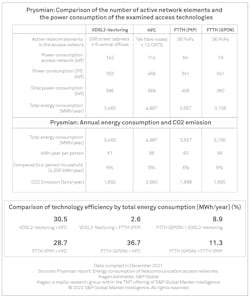International Survey Says
As sustainable and green technologies go, many communications service providers (CSPs) consider fiber rollouts to be key to achieving environmental goals. When Kagan recently surveyed 101 telecom and 42 cable professionals across the globe, only 19% of the respondents specified that environmental impact was not a driver in the decision to upgrade to fiber. Yet, the technology alone is not enough to achieve environmental goals, and governments and companies still have some way to go before knitting together a holistic approach.
Interestingly, fiber to the home point-to-point (as opposed to the point to multipoint structure in GPONs, and providing a single, rather than shared, fiber strand to each premises) is 2.7% less efficient than VDSL.
Kagan estimates Western Europe's fiber penetration at 22.2% in 2021, with Sweden as high as 69.1% and Greece as low as 0.2%. Most countries in the region have fiber plans in place, and as rollouts gather pace, our current estimate, based on existing plans, will see penetration just shy of 50% by 2030.
So how much more efficient is fiber? A study conducted by Italian telecom and energy cabling manufacturer, Prysmian Group, found that gigabit passive optical networks provide an 8.9% improvement in total energy consumption (MWh/year) when compared with VDSL-vectoring, and 36.7% versus hybrid fiber-coaxial. The advantage of GPON, from an energy efficiency perspective, is the fact that its passive, with no active optical elements between the central office and the end customer. (See Figure 1.)
Interestingly, fiber-to-the-home-point-to-point (as opposed to the point-to-multipoint structure in GPONs, and providing a single, rather than shared, fiber strand to each premises) is 2.7% less efficient than VDSL. While FTTH-PTP costs are higher, the technology supports much higher performance as well as greater product differentiation and individual line upgrade capabilities.
Belgium's incumbent telco, Proximus, also highlighted fiber's environmental credentials, noting that data transmission over fiber uses "up to 12 times less energy" than on copper. Moreover, the firm highlights that fiber is made of silicon dioxide, with silicon being "the second most abundant element on earth, after oxygen," and its exploitation "is not harmful to the environment". Proximus adds that the use and production of "2 kg of copper wire results in the emission of 1,000 kg of CO2" compared with fiber's meager 0.06 kg.
As clear as fiber's benefits are, so too is the massive, expected growth in data consumption, which increases energy use by supporting even more devices (think charging, connectivity) and increases demand for data centers, among other factors, potentially offsetting the gains made in network efficiency.
Kagan estimates Western Europe's fiber penetration at 22.2% in 2021, with Sweden as high as 69.1% and Greece as low as 0.2%. Most countries in the region have fiber plans in place, and as rollouts gather pace, our current estimate, based on existing plans, will see penetration just shy of 50% by 2030.
On fixed networks, the clearest short-term benefit for the operators in terms of both ESG and revenue will be the retirement of copper networks in Europe, and cable's eventual shift to full fiber. Timelines for the network shutdowns are still not universally transparent in Europe, given that much relies on the transition to fiber and third-party network carriers' shift to the new networks.
An additional benefit to shutting down copper networks is recycling. Proximus said its decommissioning of copper creates a stockpile of 500 tons of copper each year. At the COMEX average price for 2021 of $4.24 per pound, this equates to an annual value of $4.7 million.
About the Author: Mohammed Hamza is Principal Analyst at Kagan, a group within S&P Global Market Intelligence's TMT offering. He has more than 18 years of experience in media and telecoms. For more information, please email [email protected] or visit https://www.spglobal.com/marketintelligence/en/.
Follow S&P Global Market Intelligence on:
LinkedIn: https://www.linkedin.com/company/s&p-global-market-intelligence/
Facebook: https://www.facebook.com/SPGMarketIntel/
Twitter: https://twitter.com/spgmarketintel
YouTube: https://www.youtube.com/c/SPGlobalMarketIntelligence
Instagram: https://www.instagram.com/spgmarketintel/
About the Author
Mohammed Hamza
Mohammed Hamza is Principal Analyst at Kagan, a group within S&P Global Market Intelligence's TMT offering. He has more than 18 years of experience in media and telecoms. For more information, please email [email protected] or visit https://www.spglobal.com/marketintelligence/en/.
Follow S&P Global Market Intelligence on:
LinkedIn: https://www.linkedin.com/company/s&p-global-market-intelligence/
Facebook: https://www.facebook.com/SPGMarketIntel/
Twitter: https://twitter.com/spgmarketintel
YouTube: https://www.youtube.com/c/SPGlobalMarketIntelligence
Instagram: https://www.instagram.com/spgmarketintel/

